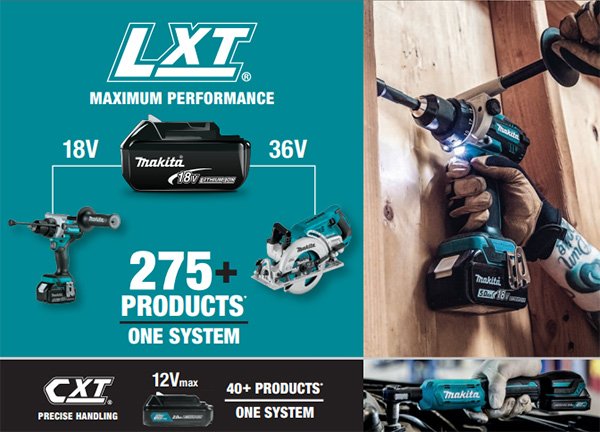
If you buy something through our links, ToolGuyd might earn an affiliate commission.
I wrote about Makita’s new XGT 40V Max cordless power tool lineup separately. Here, we’ll take a look at the XGT system alongside Makita’s 18V LXT cordless power tool system in broader context.
Makita “ONE SYSTEM” Marketing
Makita has been advertising XGT as a One System solution, and provided additional details about what they mean by this.
Their argument points towards Dewalt, and how, if you want to take advantage of Dewalt’s highest performing cordless power tools, you really need to buy into two separate systems – FlexVolt and 20V Max. While FlexVolt cordless power tool batteries will power Dewalt’s 20V Max tools, it’s not going to be the most ergonomic fit for smaller tools, such as an impact driver.
Thus, Makita explains, Dewalt users really need to buy into two systems to get the best of both 20V Max and FlexVolt platforms.
What about Milwaukee? If Milwaukee M18 cordless power tool users want to tap into the brand’s MX Fuel cordless light equipment lineup, that’s a separate cordless system they need to buy into. You cannot get everything from one system.
Frankly, I don’t agree with Makita’s analogy, and not only that, nothing in Makita’s XGT lineup looks to match up with what Milwaukee offers in their MX Fuel lineup, at least not at launch. For example, where’s Makita’s cordless demolition breaker? Are Makita XGT and their 18V form-factor batteries really going to match up against Milwaukee’s MX Fuel line of cordless equipment?
Makita says that XGT will outpower, outsmart, and outlast the competition, although that remains to be seen.
Makita USA has put a lot of emphasis on the “competing brands require 2 systems” messaging. I understand the point they’re trying to make, although I don’t agree with it. How are users going to fit the upcoming super-sized XGT 40V Max 5.0Ah battery onto an impact driver?
Fast forward 5 years, to when Makita will have expanded their XGT 40V Max cordless power tool system by quite a bit. At that time, there will hopefully be a healthy selection of products, and XGT might indeed be a “One System” solution.
But right now, Makita is launching XGT with a limited selection of tool categories. If you want something they don’t yet offer – and might never offer – you are going to have to buy into a completely separate lineup.
What About Makita 18V LXT?

Makita insists that they will continue to launch new products for their 18V LXT cordless power tool system.
But, what if you want any of the new features being touted about the XGT 40V Max platform? It does not look like these benefits will come to the 18V lineup.
If a Makita 18V or 18V X2 cordless power tool users wants higher-powered or more featured tools, or something that’s unique to the XGT lineup, what options will be available to them, other then having to buy into a completely separate system?
Makita 18V and 40V Max XGT cordless systems are not compatible with each other, with the only cross-platform option being a one-way charging adapter.

Makita recently launched a new 18V cordless hammer drill, model XPH14. We cautioned that you should wait on buying it, and for good reason.
Despite being launched after the XGT 40V Max brushless drill and hammer drill launched overseas, the latest 18V LXT flagship drill does not include Makita’s AFT active feedback-sensing safety tech.
Makita’s XGT 40V Max drill (GFD01D) and hammer drill (GPH01D) deliver the same 1,250 in-lbs of max torque as the 18V XPH14. The XGT’s motors will turn off when binding occurs, and the LXT’s motors will not.
This AFT tech will not be included in Makita’s XGT compact cordless drills. Still, is there a reason their new high torque 18V LXT hammer drills don’t feature this anti-kickback safety feature?
Read Also: Flex Brushless Drill will Feature Anti-Kickback Tech and 1400 in-lbs max torque
Makita strongly emphasizes that they will continue to support the 18V LXT system. At this time, there is no reason to contradict that, but it’s also not a good idea to pretend the 18V and 40V Max XGT systems will see similar advancements over the next few years. If there are already differences in product features now, there’s no reason to assume this isn’t the pattern Makita will follow.
Until Makita’s roadmap is clear and we see the paths the two systems take, neither of Makita’s main cordless lines are truly “One System” options.
Can You Upgrade from Makita 18V LXT?
When Dewalt came out with their FlexVolt system, users knew that the 60V Max batteries would be backwards-compatible with their 20V Max tools. Now, we also have Dewalt 20V Max tools that can deliver a power boost when powered by FlexVolt batteries.
See Also: Dewalt Power Detect | Dewalt FlexVolt Advantage
Makita 18V XGT users do not have that same benefit. There’s an XGT charger to 18V battery adapter accessory, and that’s it. In other words, at this time there is no upgrade path.
Because of this, XGT 40V Max (and 40V Max X2 or 80V Max) has to be treated as an entirely new cordless system.
Why buy into Makita’s XGT cordless system – or even their 18V LXT system – when Dewalt 20V Max and FlexVolt or Milwaukee M18 cordless systems are already mature and robust systems?
When Dewalt launched FlexVolt, it was a new higher powered cordless tool system that appealed to all users, and it also provided benefits and conveniences to existing 20V Max users.
Milwaukee has stuck with M18 for their handheld power tools and construction, automotive, and trades-specific tools, so that one battery interface can be used throughout.
Even Bosch, with their new oddly-named Profactor tools, ensured their higher powered tools are compatible with batteries that can also power most of their other 18V cordless tools, except for their 12Ah battery that’s exclusive to the new lineup.
Makita 40V Max XGT is not an upgrade choice, it’s an entirely new and different system.
We’re at that awkward stage where we don’t yet know what will happen. Is Makita’s 18V LXT system a dead-end? Makita will need to show that they intend to support it.
Dewalt launched their new 20V Max Li-ion cordless power tool system 10 years ago, and they did so without any adapter solution for existing 18V users. There was a lot of grumbling about this over the years, and it took Dewalt 4 years to come out with a cross-platform battery adapter. You can still buy Dewalt 18V batteries today, but the lineup has been largely discontinued and expansion has stopped years ago. At the time, Dewalt also said they would continue to support their 18V system.
Makita is going to have to make a very compelling case for their 40V Max XGT lineup. And, if there are any advantages, how long until competitors catch up?
Make no mistake, it was probably the right choice for Makita to start a new cordless platform from scratch. Their 18V LXT lineup seems to have reached its limits, and the XGT platform will allow the brand to offer solutions that currently aren’t possible with their 18V system. This isn’t inherently because of the 40V Max voltage – I don’t think – but because the new interface and tools are designed with modern needs and battery capabilities in mind.
We’ll have to see what happens.
In the meantime, you can upgrade from 18V LXT to 40V Max XGT, but you’ll find a lot of tools missing, and you’ll also have to buy everything new. If you’re going to have to do that – buy into a completely separate system, why XGT over competing options?
40V Max XGT Batteries Compared to Other Brands’ Systems
Makita has not addressed this.
Consider Milwaukee’s M18 12.Ah battery pack, which on paper has 18V x 12Ah = 216 watt-hours of energy storage. Now consider Makita’s 40V Max XGT 2.5Ah battery, with its 36V x 2.5Ah = 90 watt-hours (based on nominal voltage) rating.
Makita has a 4.0Ah (144 watt-hours) battery also launching, and a 5.0Ah battery (180 watt-hours) on deck.
Consider Milwaukee’s higher capacity MX Fuel battery – it’s rated at 72V and 6.0Ah, for 432 watt-hours of energy. If you take two of Makita’s 40V Max XGT batteries in an 80V Max configuration, and even if you consider their on-deck 5.0Ah batteries, that’s 36V (nominal) x 2 x 5.0Ah, or 360 watt-hours.
As an aside, Makita’s 40V Max XGT 5.0Ah battery pack is believed to have 20 Li-ion cells, whereas their 2.5Ah and 4.0Ah batteries are believed to have 10 Li-ion cells.
Competing brands’ 18V 12Ah batteries utilize 4.0Ah battery cells, likely similar to the 4.0Ah cells Makita is using in their 40V Max XGT batteries.
Milwaukee, Bosch, and Dewalt step up to 3-rows of cells, for 15 cells total, in their largest 18V-sized 12.0Ah batteries. There’s the potential to go to 5.0Ah cells in the future. (Dewalt’s 12Ah battery is their FlexVolt, spec’ed at 4.0Ah at 60V Max and 12.0Ah at 20V Max).
When talking about a Makita 80V Max XGT product, it is powered by 2 batteries, and given what we know, that would mean 2 x 10 cells each for 20 cells total. THIS is where Makita has an advantage, similar to the advantage their 18V X2 products held for some time. Dewalt has FlexVolt 120V Max products, although they haven’t explored that potential outside of cordless miter saws, and Milwaukee has not yet pushed their products into multiple battery territory.
How Will Makita 18V and 40V Max XGT Tool Systems Coexist?
Makita says that LXT and XGT will coexist – they insist on this.
Will Home Depot, likely Makita USA’s biggest retail partner in the country, set aside shelf space for both LXT and XGT cordless power tool lines?
Will XGT indeed be a “One System” platform where users can find a broad range of cordless solutions from light to heavy duty?
If or when Makita comes out with a cordless table saw, will tools launch to both platforms? When will cordless vacs or dust extractors come to the XGT lineup? Cordless nailers?
Despite Makita’s insistence about their continued plans for the 18V LXT lineup, users don’t know what the future for LXT holds. Makita previously implied that next-gen higher capacity batteries are never coming to the 18V LXT line. It seems clear from Makita’s product differentiations that XGT will see more advanced features and tech options.
At launch, the 18V LXT tools are more affordable. Given that the Makita 40V Max XGT system maintains an 18V form factor, I would assume lot of the higher costs are likely attributed to the tools’ more advanced features.
5 years from now, will 18V LXT tools share some of the same features as the XGT lineup, or will more price-conscious options come to the XGT lineup, closely overlapping with or even replacing 18V LXT options?
For existing Makita 18V cordless power tool users, if you want any of the new XGT tech, you’re going to have to buy into and deal with TWO SYSTEMS. If you want to buy into 40V Max or 80V MAX XGT systems, what if you want a cordless jig saw, a drywall cutter, a vacuum, or a cordless ratchet? Well, you’re going to have to buy into TWO SYSTEMS.
There are some tool categories where the XGT system doesn’t make perfect sense, such as sub-compact cordless drills and impact drivers, and so I can’t really imagine a future where the 18V system goes away. Maybe the CXT lineup will step up to bridge the gap?
I can envision a roadmap for Makita that involves expanding upwards towards higher powered tools, and also in the direction of 18V LXT.
Maybe there might eventually be adapters if or when Makita is ready to retire the 18V LXT lineup – IF that ever happens?
It’s possible that Makita will very strongly define the boundaries between 18V LXT and 40V Max XGT systems, with just a small area of overlap in between. However, this seems contrary to their “One System” marketing. From what I can tell, XGT is a long way from being a one system cordless solutions provider, and the system would have to cannibalize a lot of what the LXT system offers before Makita’s One System philosophy can be achieved.
What Should You Do?
Makita’s XGT launch will present a lot of “I don’t know what to buy” feelings for a lot of users.
Are you a professional user who earns a living with their tools? If you have immediate needs, you’re in a tough spot. Buy what you need for the performance, features, or efficiency advantage you need now and in the foreseeable future.
For everyone else, there’s no pressure to decide anything yet, right? Also, remember what I said last week – this will be a big year for cordless power tool tech.
Is this a transitional stage where Makita winds down their 18V system? Possibly, but probably not. The 18V LXT system is large enough where Makita could not and would not flip a switch on it overnight.
At this time, I’m trying to imagine what Makita’s cordless landscape will look like 2-5 years from now. With respect to the foreseeable future, Makita’s claim about 18V and XGT 40V Max systems coexisting side by side seems to be absolutely trustworthy.
That being said, I don’t know if I would buy into either system right now as a new user. We don’t know quite where Makita’s boundary lines will separate 18V and XGT systems, and until their product roadmaps become clear, neither of Makita’s discrete systems match up to competitive offerings individually.
If you have broad tool needs and wants, and you want to go with Makita, be prepared to have to deal with two separate and incompatible tool and battery systems. This probably won’t always be the case, but it is right now. If I had to go with two separate systems, I don’t know if Makita’s 18V system would be one of those choices. If I’m being honest, I don’t know if XGT would be one of those choices either right now.






